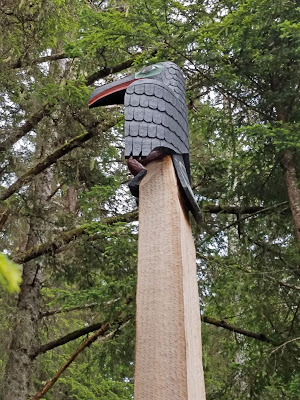We continued our walking tour of Sitka.
 |
| Russian Bishop's House (1841-1843) is the oldest intact Russian building in Sitka |
 |
| Hanlon-Osbakken House (1892-1896, in Queen Anne style) |
 |
| A sign directed Kent to call a number, and he was then given a code to open a lockbox; he retrieved a key for the front door so that we could enter to wait for the receptionist |
 |
| Apparently the motel has rented the ground floor rooms to local retail businesses, so it looked like a strip mall |
We drove back into town to meet Jan & Kirby for dinner at Rio's Wine Bar, which is above Ludvig's Bistro, the popular restaurant that was fully booked. However, at Rio's we could order Ludvig's famous clam chowder. The chowder included chourizo that gives it a nice zing.
 |
| Alaska Native Brotherhood Hall (1914), the original chapter of an Alaska-wide Native organization, founded in 1912 to fight discrimination in restaurants and movie theaters |
 |
| Saanaheit Totem and a pair of house posts (KSS) |
 |
| The trail heading into the hemlock and Sitka spruce forest |
 |
| Jan & Kirby told us about "nurse logs" upon which seedlings grew until the nurse log had completely rotted, leaving a gap in the trunk/root system |
 |
| Some root systems are more convoluted than others (KSS) |
 |
| Indian River estuary (KSS) |
 |
| The bottom of the K’alyáan pole has the frog, the crest of the local Kiks.ádi clan, and the raven helmet worn by K’alyáan, the warrior leader (KSS) |
 |
| Nurse logs nourishing young trees |
 |
| Mosquito Legend Totem (1938-1941 replica by Frank Kitka of the CCC, to replace the pole that was donated in 1903) is a Haida carving of a Tlingit tale |
 |
| The Mosquito Legend Totem is topped by the Village Watchman and below him is the Tlingit figure, Guteel, who is the creature from which mosquitoes originated |
 |
| Raven Crest Pole (1983 replica of a totem donated in 1903, by Nathan Jackson and Steve Brown) (KSS) |
 |
| A closer look at the whale on the Raven Crest Pole |
 |
| View across Crescent Bay |
 |
| Yaadaas Crest Corner Pole (1982 replica by Nathan Jackson and Steve Brown) would stand at the corner of a clan house |
 |
| Cormorant Memorial/Mortuary Column (2015 replica by Tommy Joseph of a pole donated in 1903) was either used as a memorial or as a mortuary pole if it contained the ashes from a cremation (KSS) |
 |
| Tamiko approaching the Wolf Crest Pole (1982 replica by Reggie Peterson of one donated in 1903) (KSS) |
 |
| Wooch Jin Dul Shat Kooteeya/Holding Hands Centennial Pole (2011 by a team led by Tommy Joseph) to celebrate Sitka National Historical Park’s 100 year anniversary) |
 |
| An original section of Yaadaas Crest Corner Pole; many of the original totems can be found inside the park's Visitor Center, or on the porch like this one (KSS) |
 |
| Totems around the park's parking lot |
 |
| It had cleared enough to see the mountains on Sitka's Baranov Island |


No comments:
Post a Comment